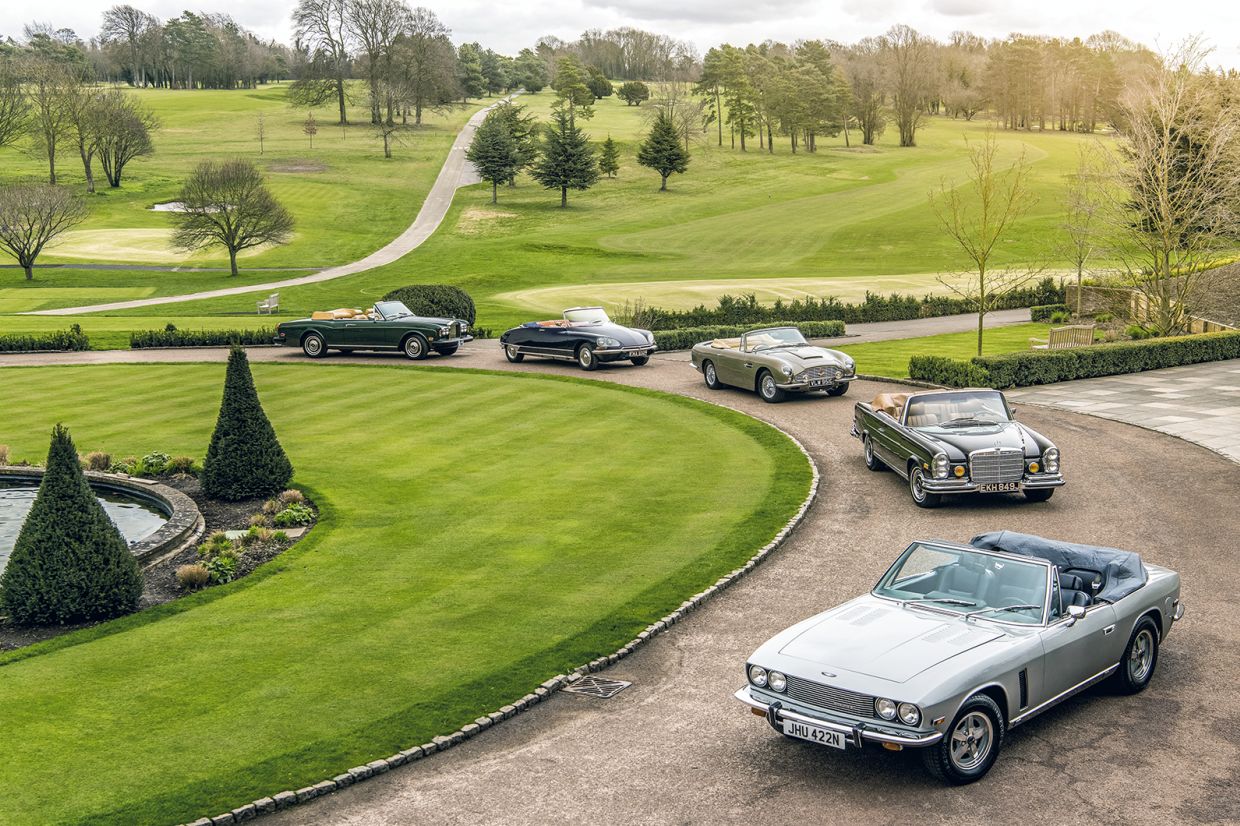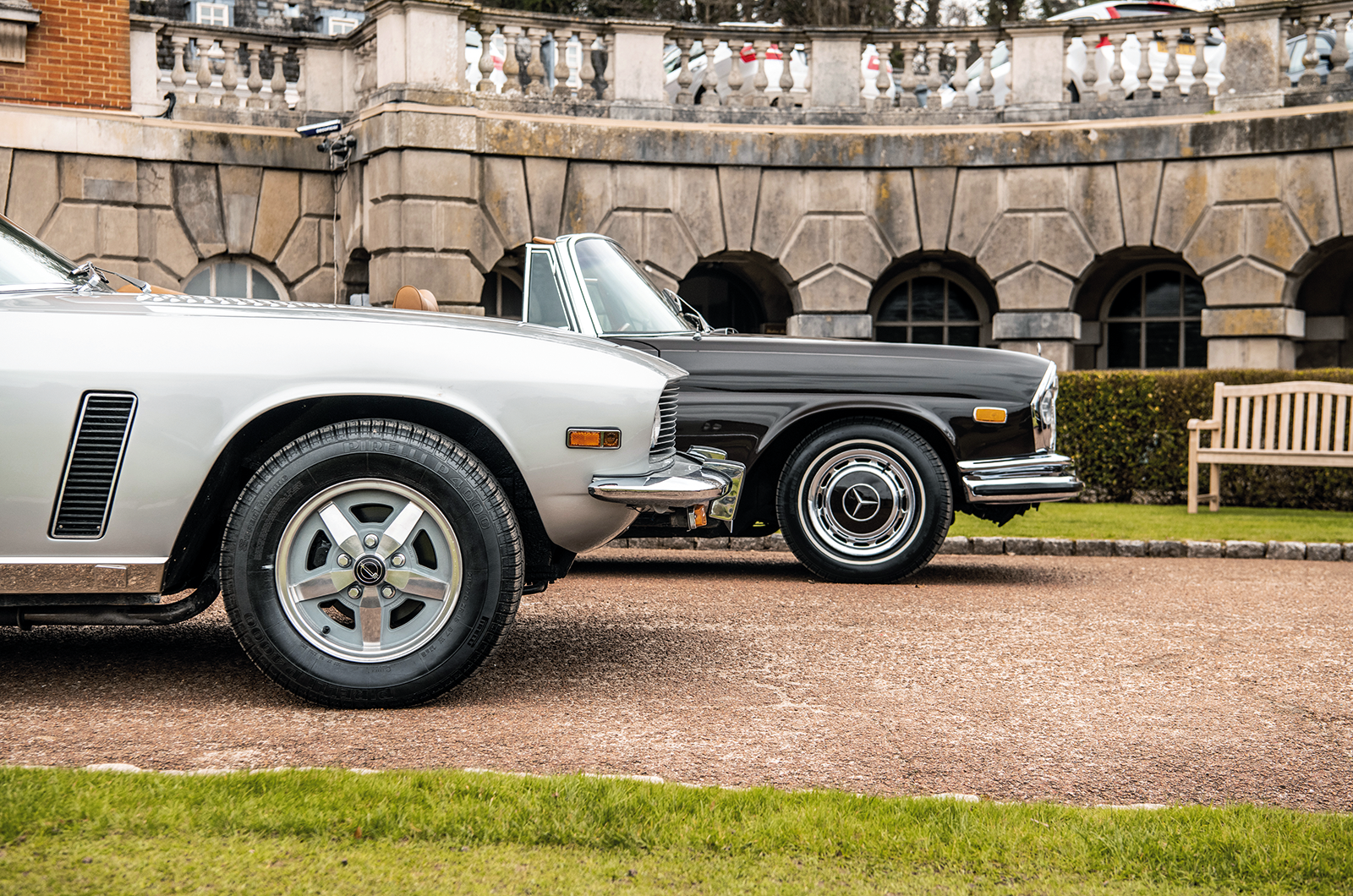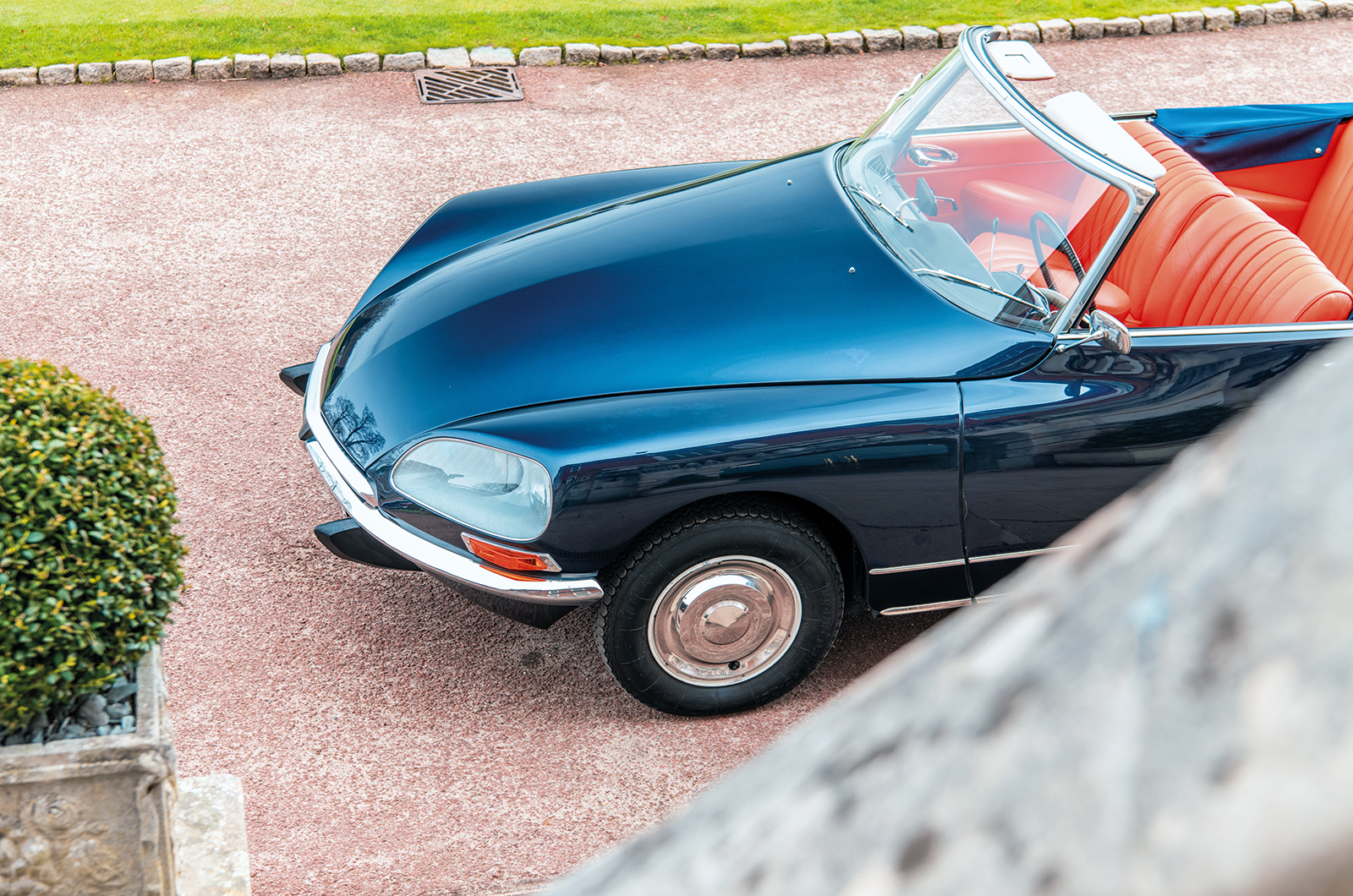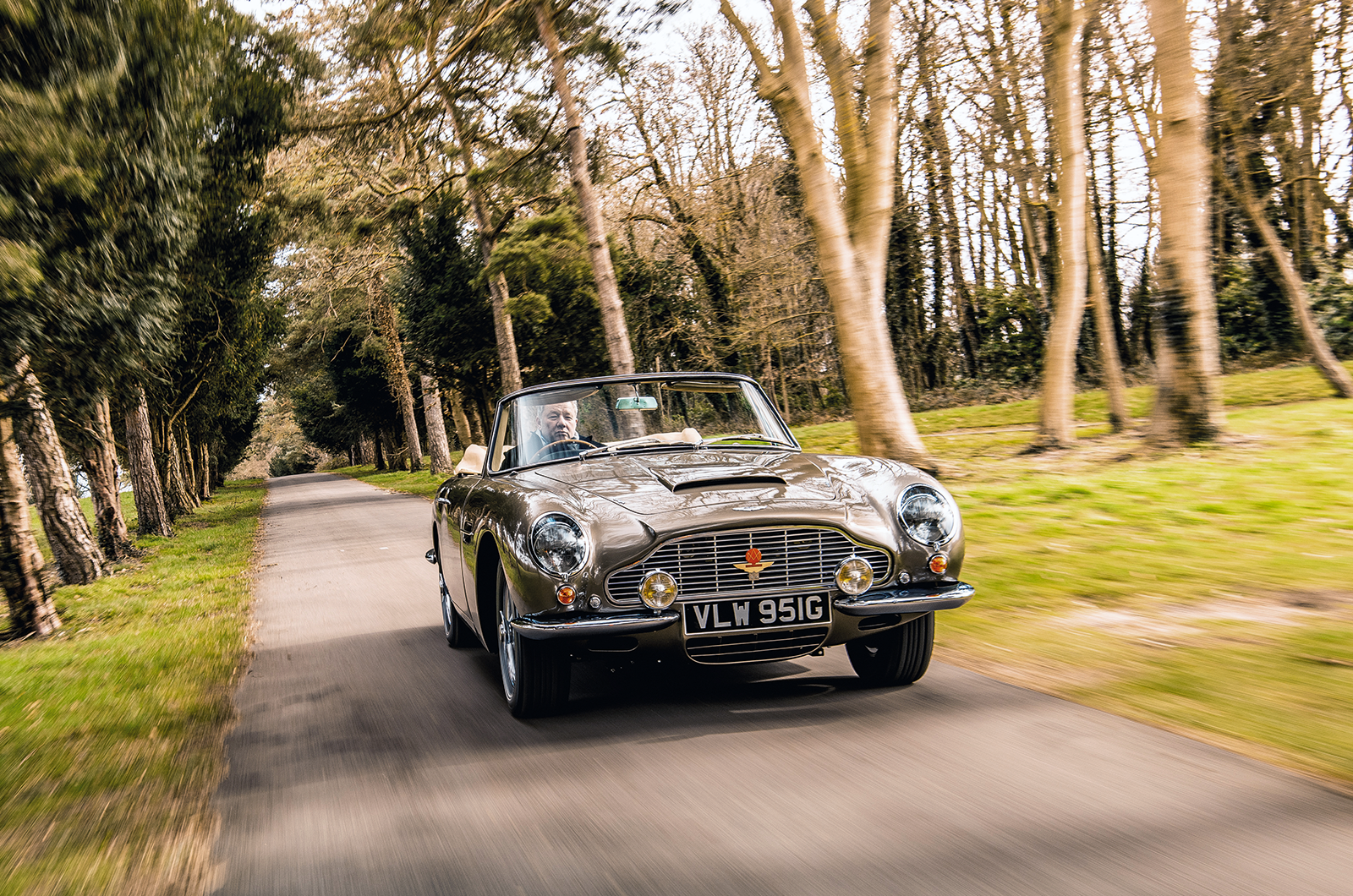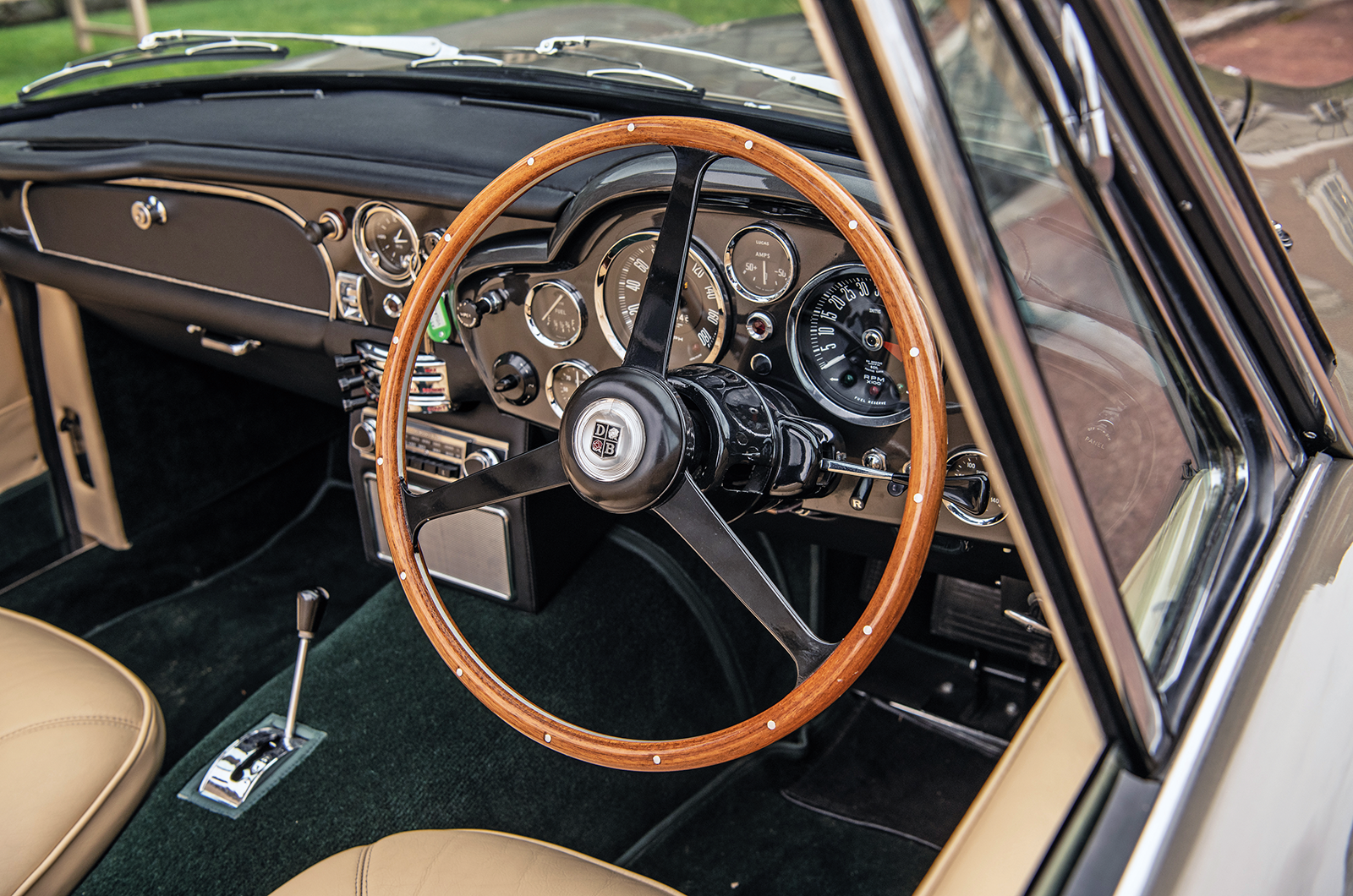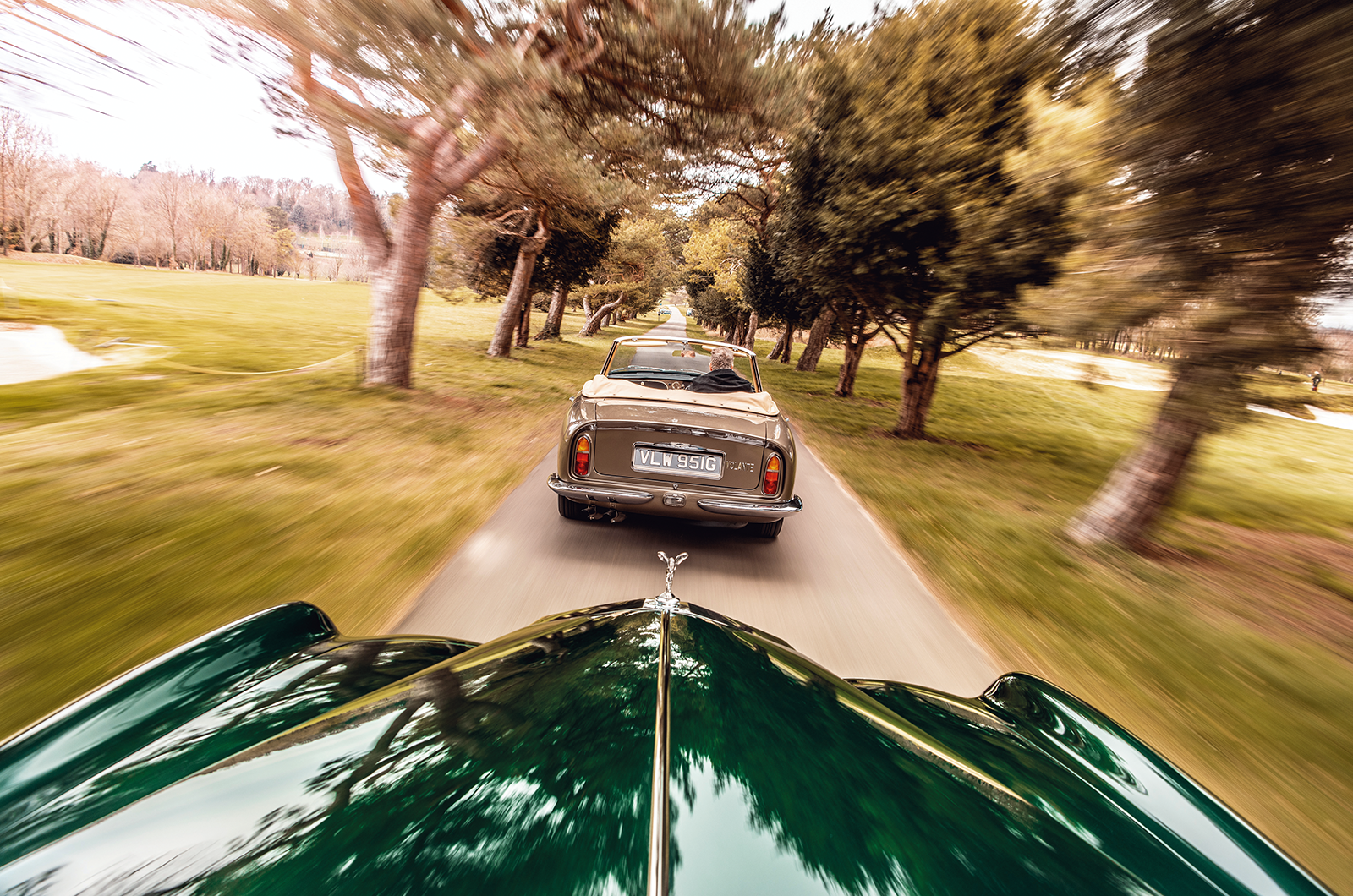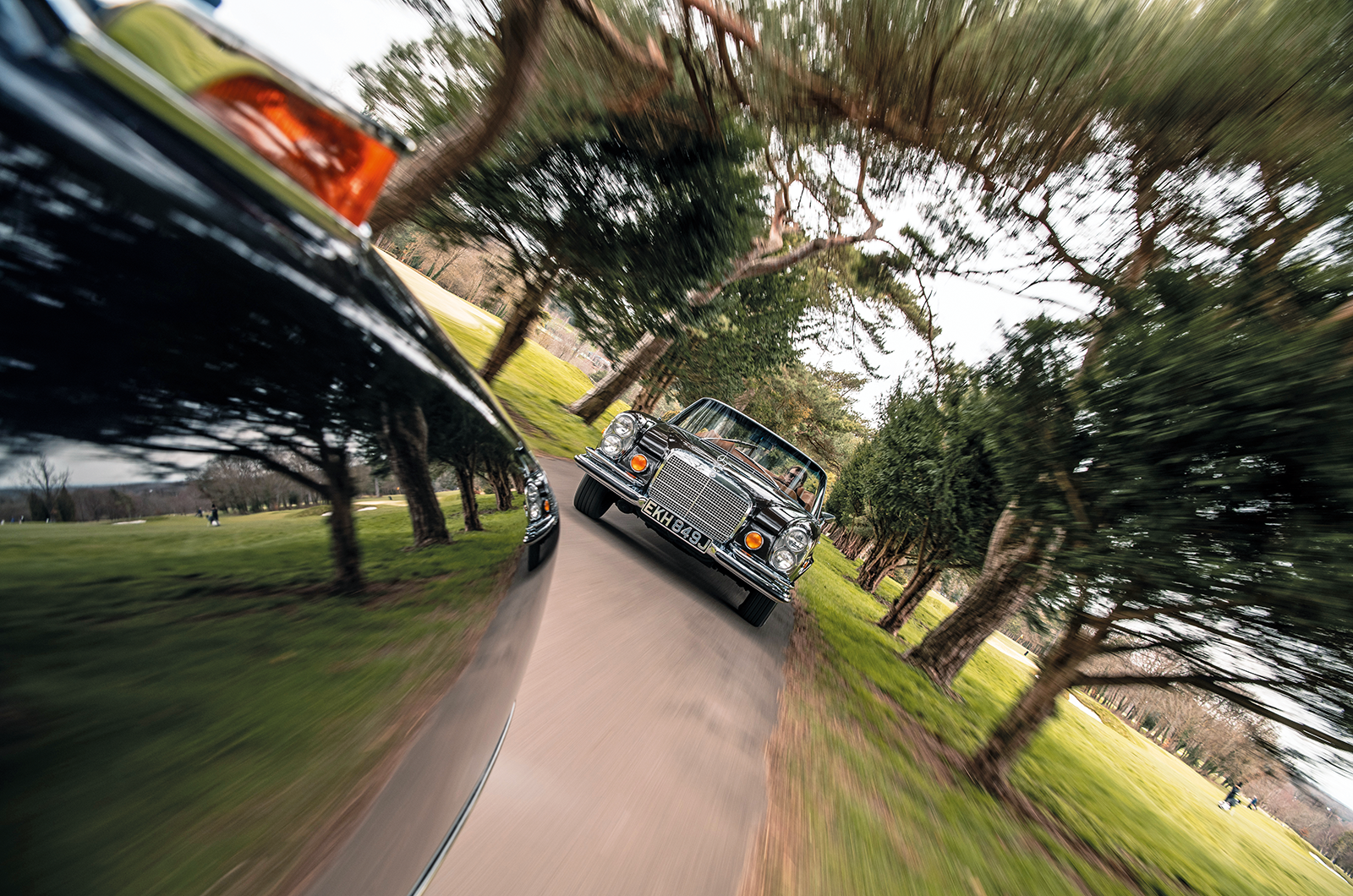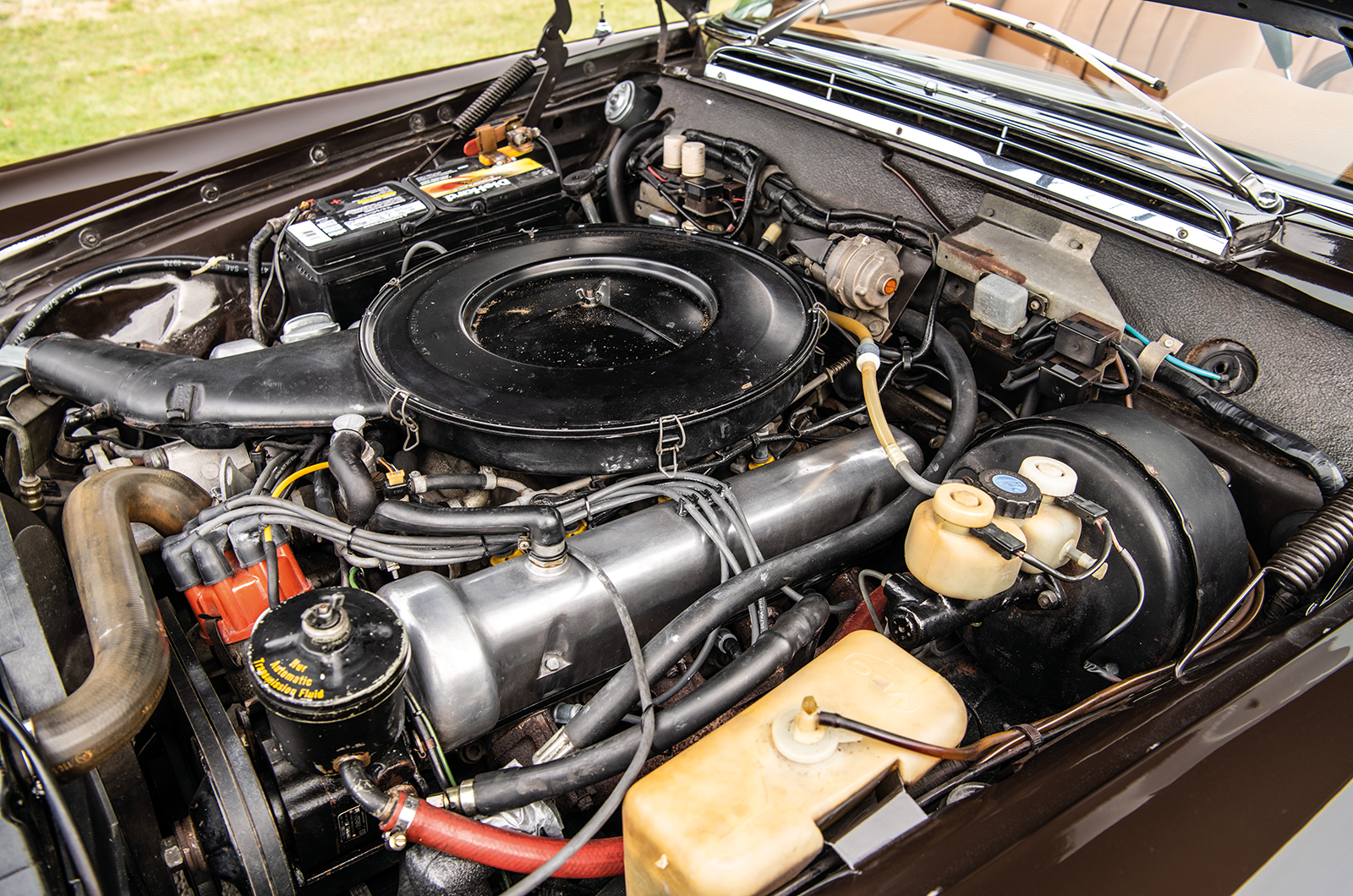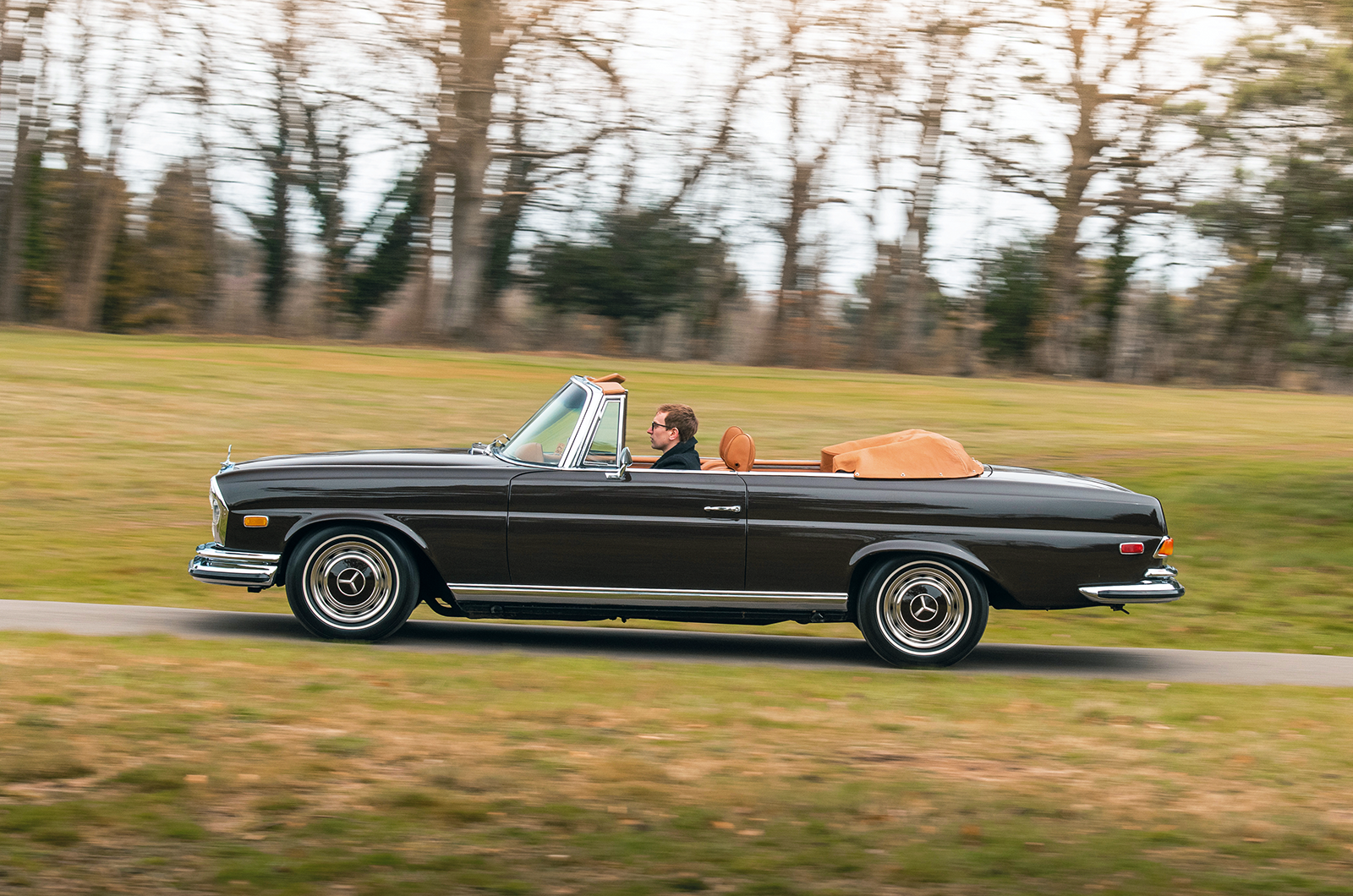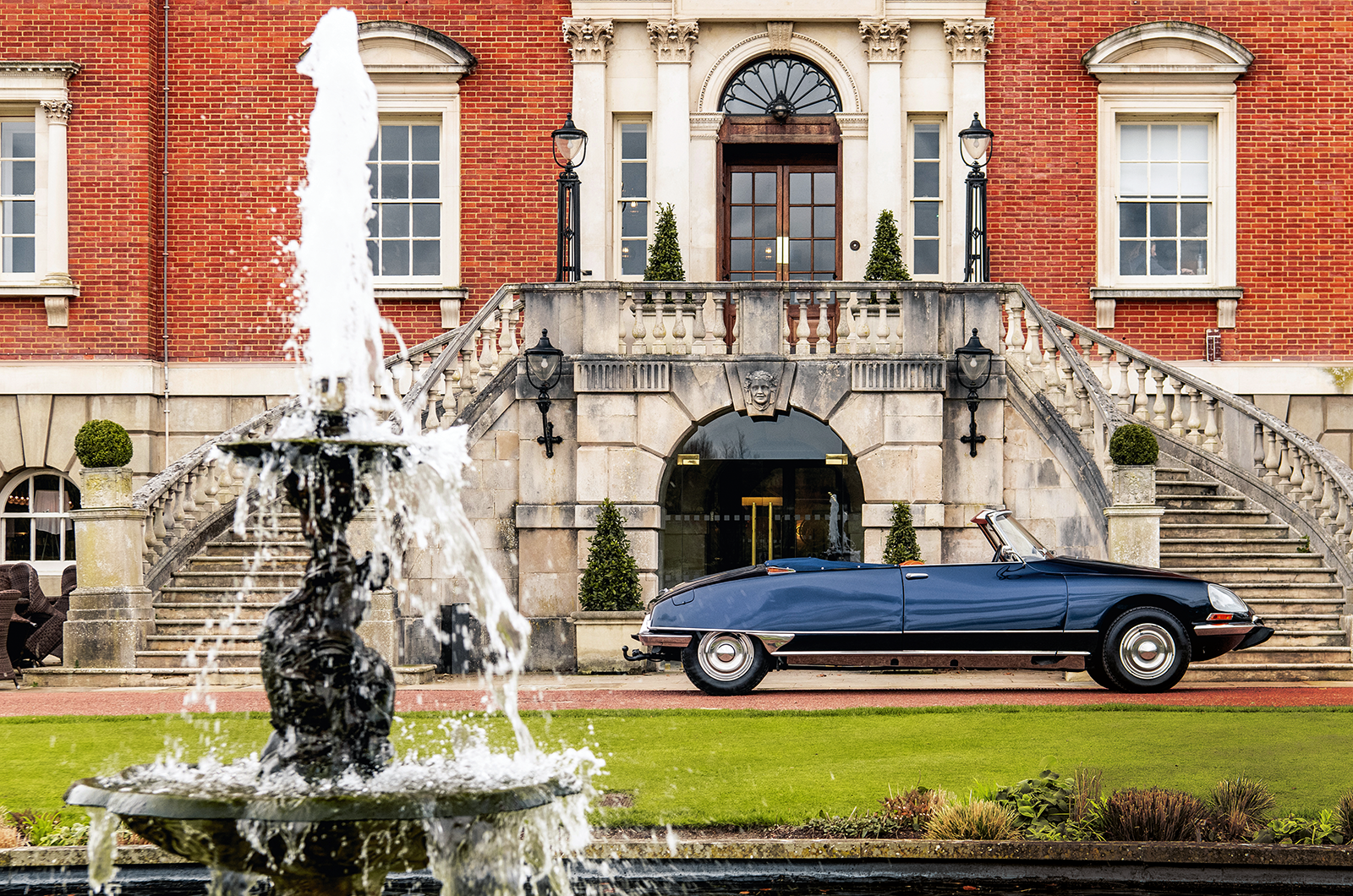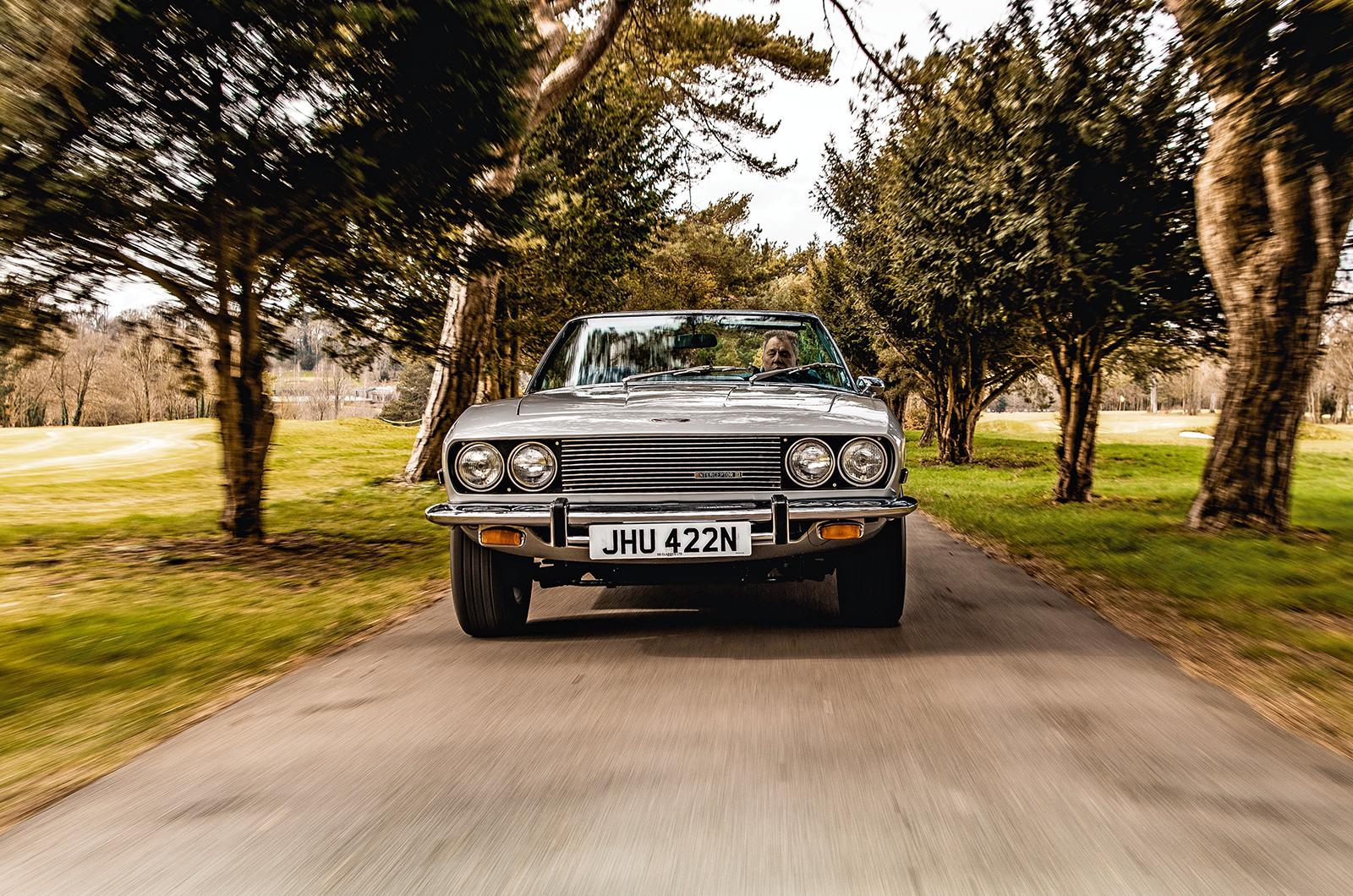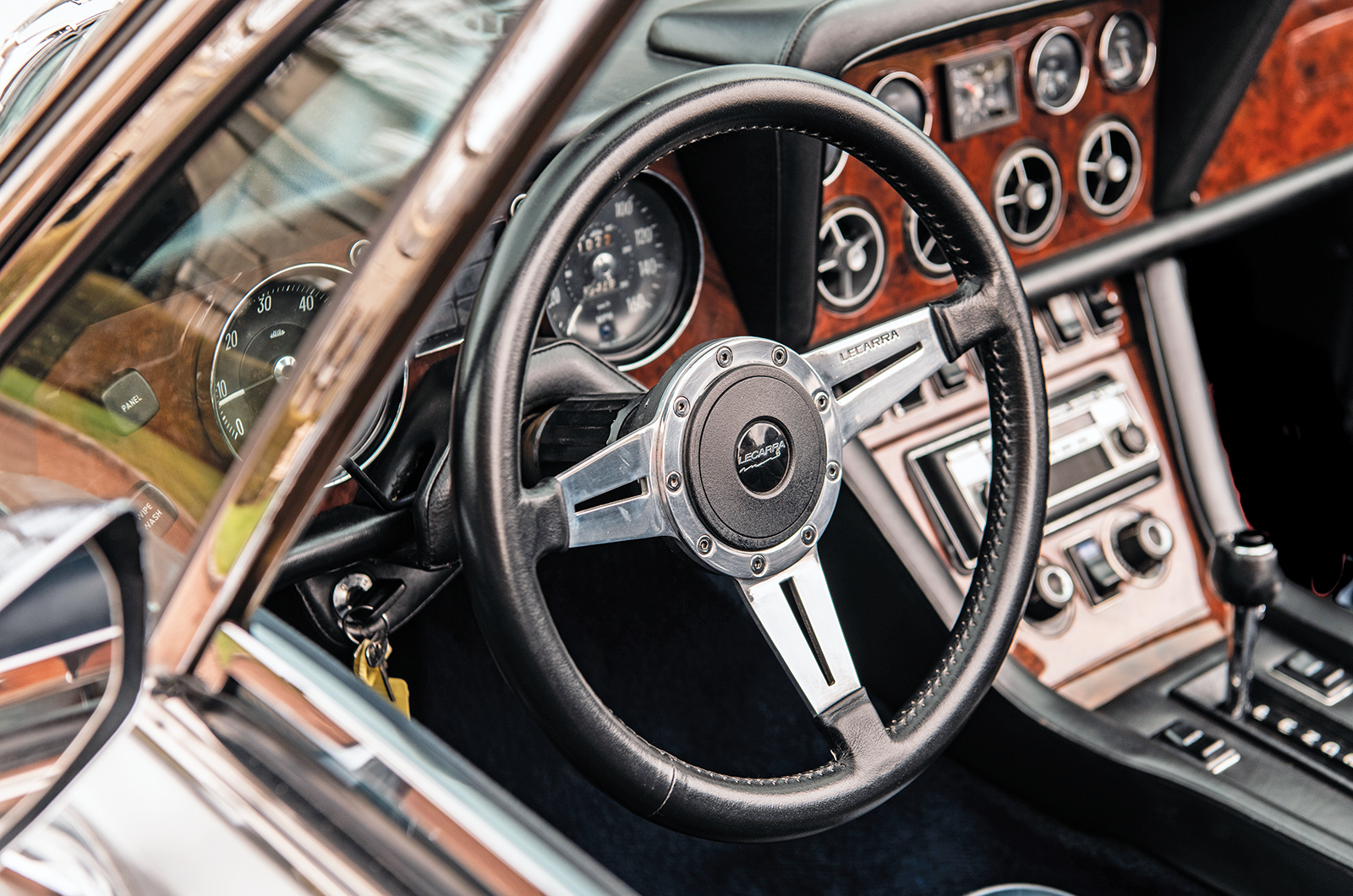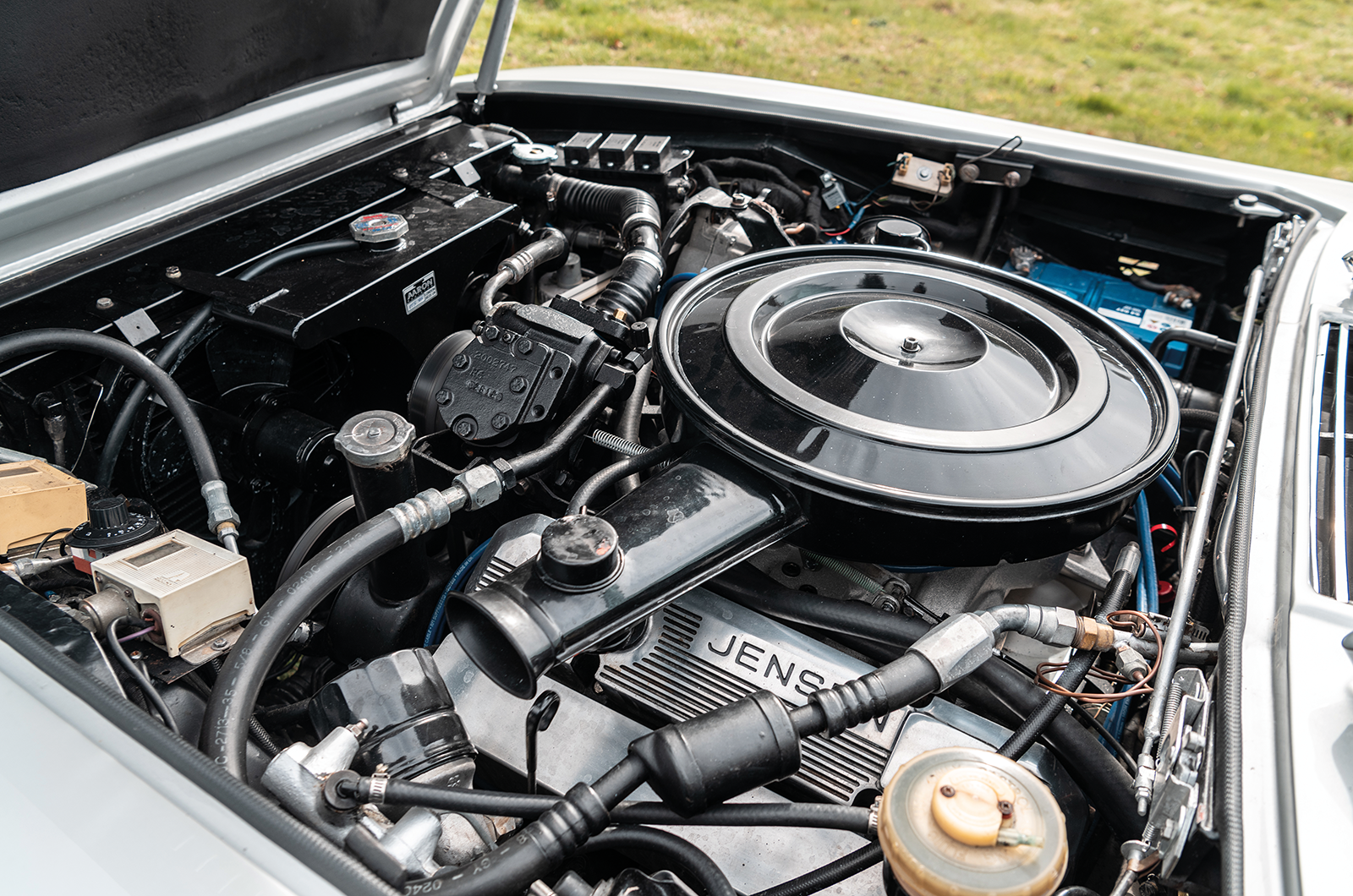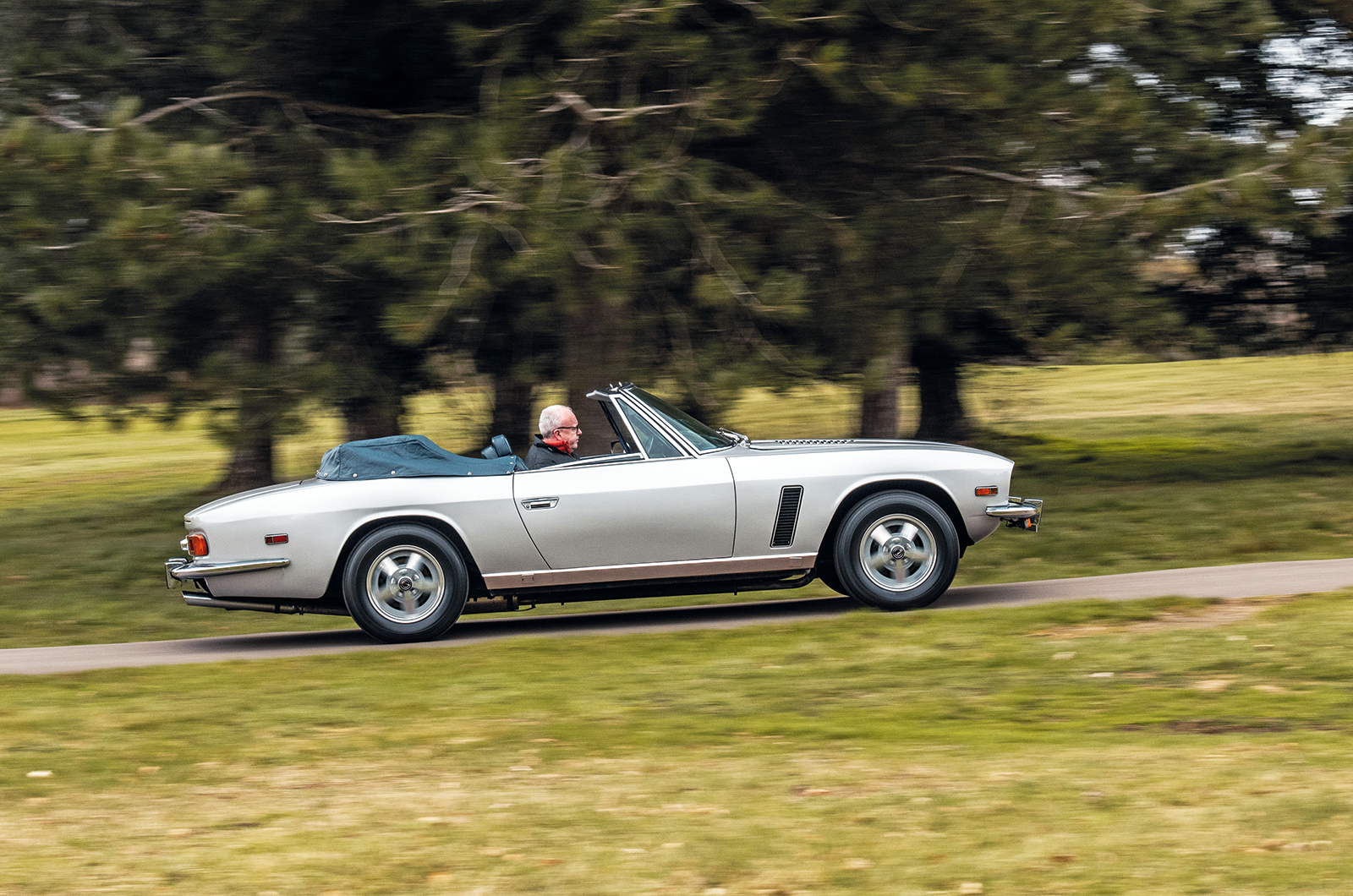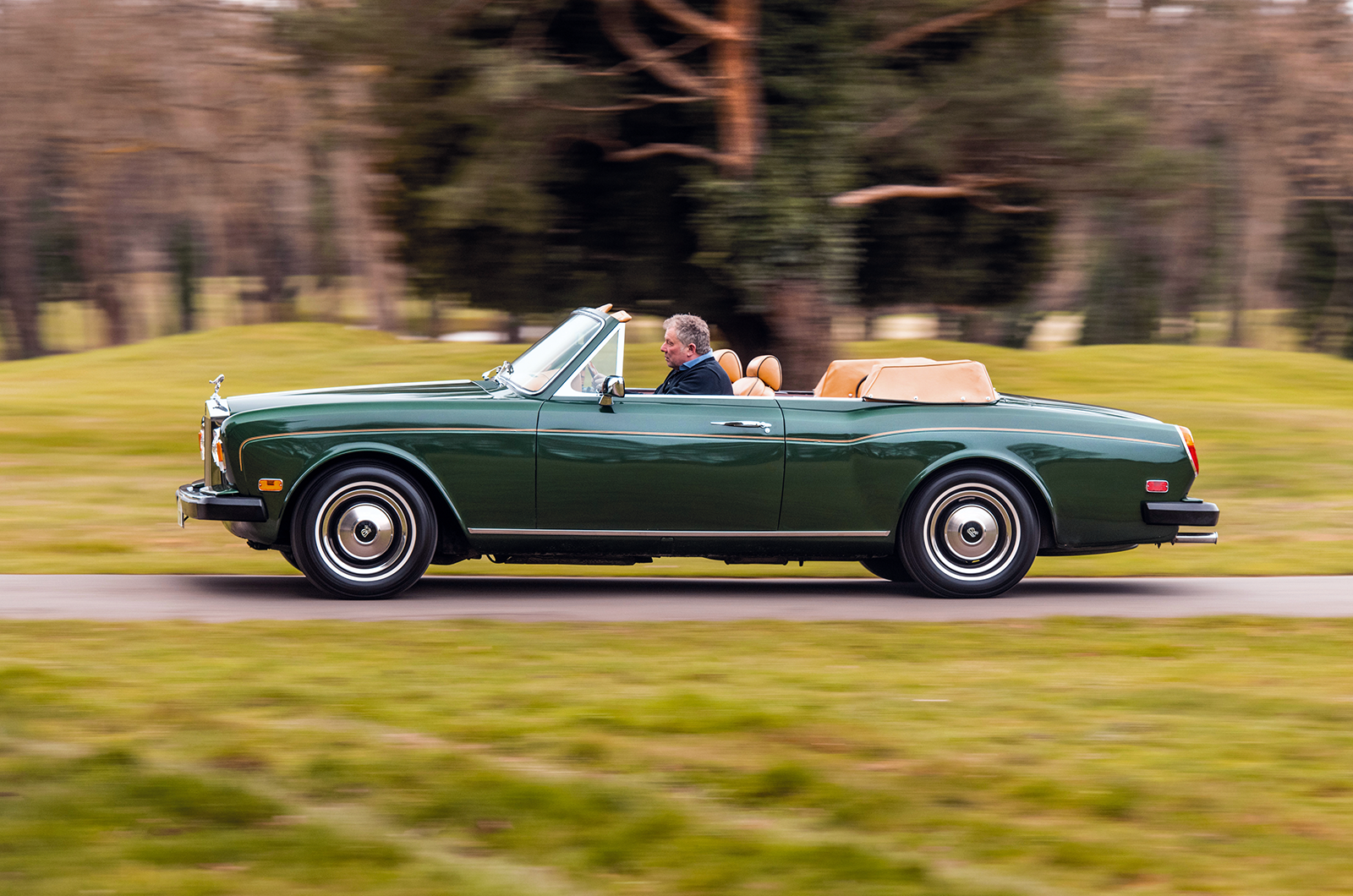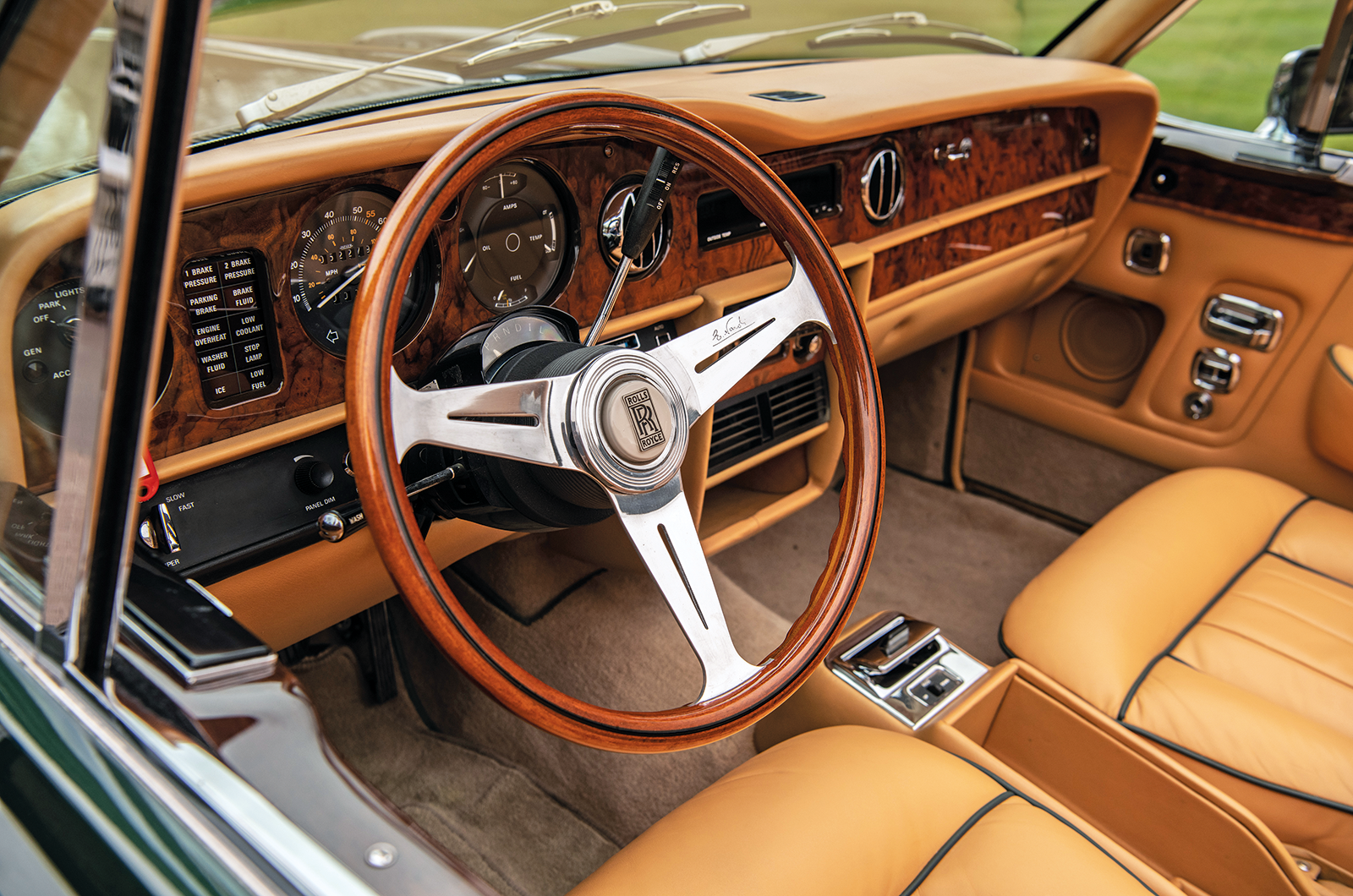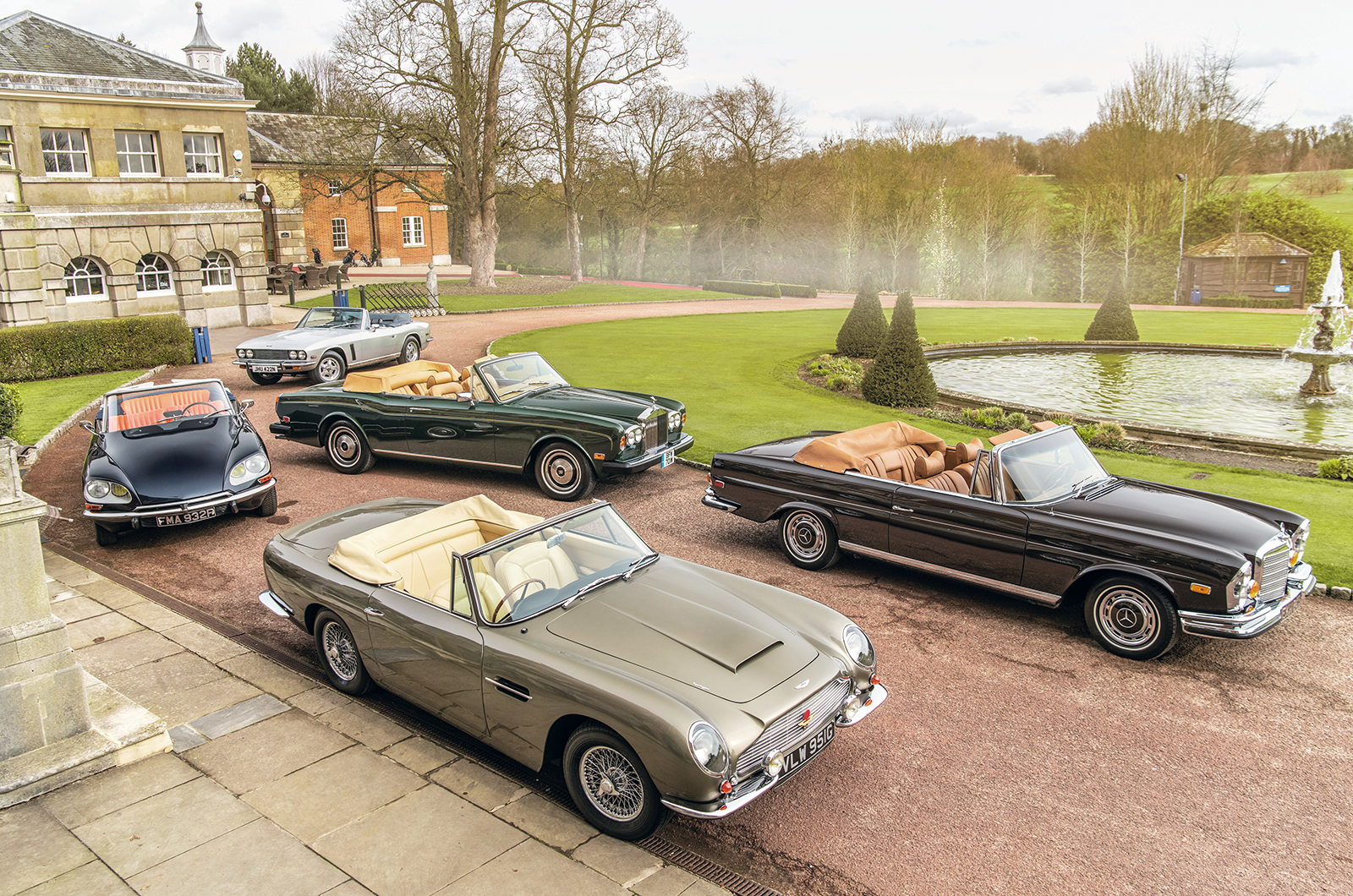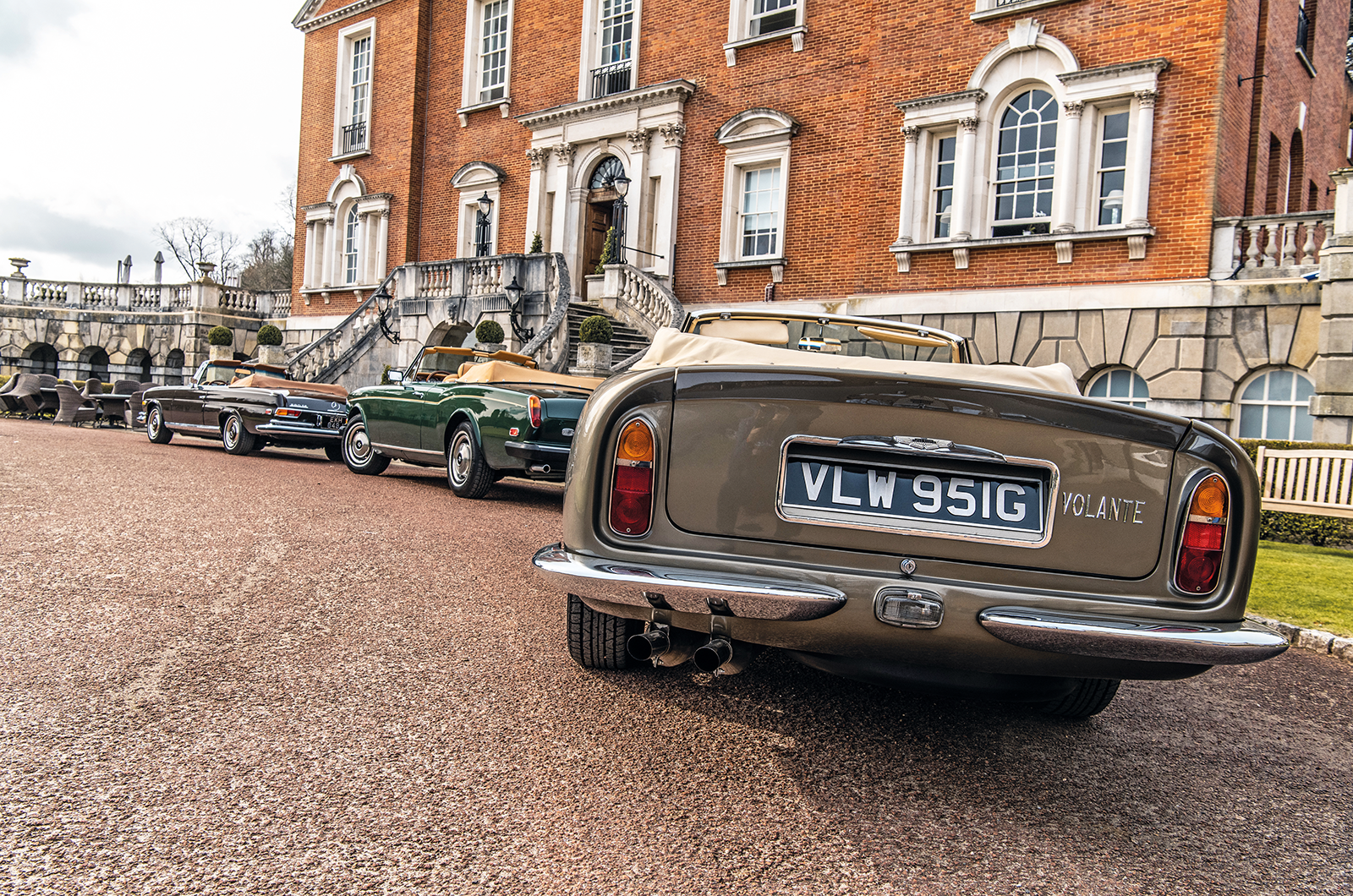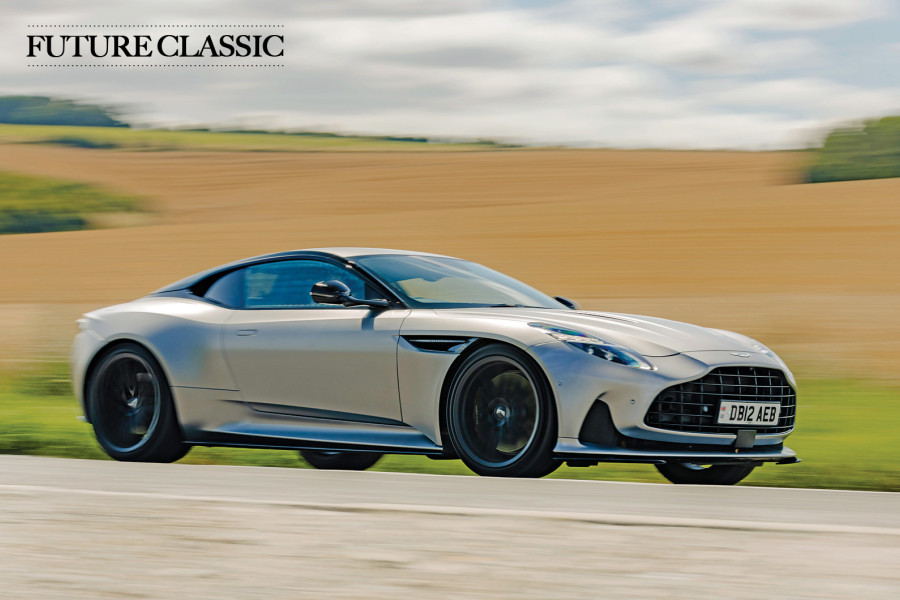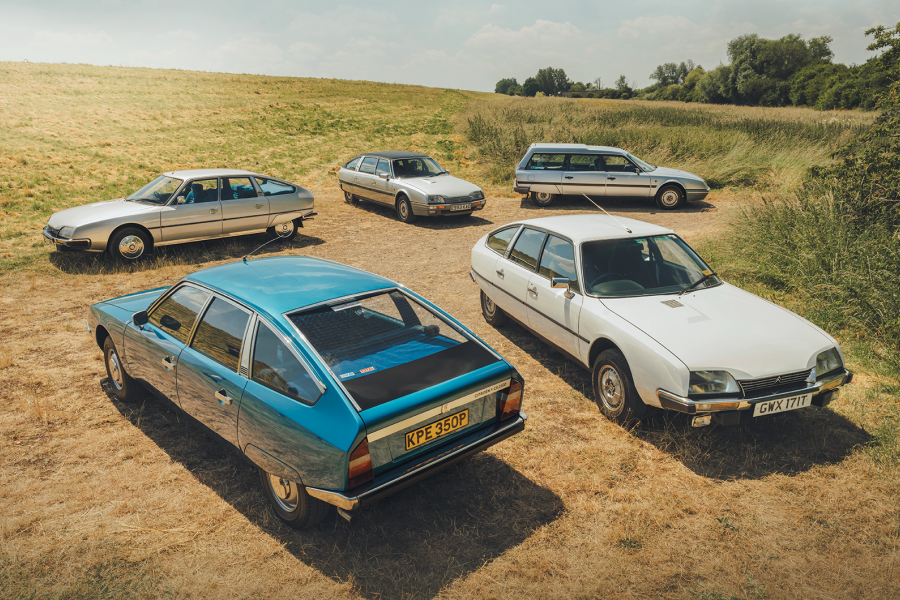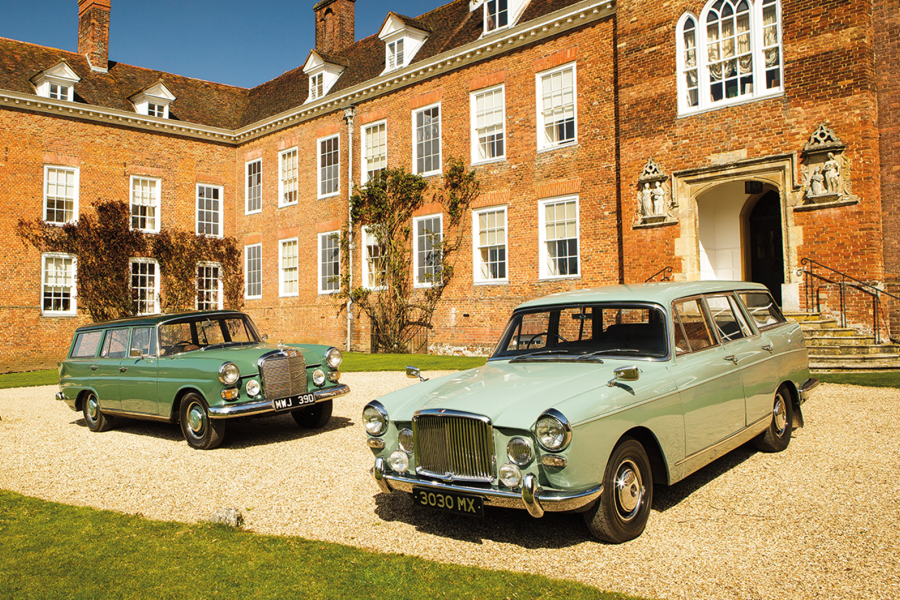In platinum silver, with a power-operated blue Everflex hood, the Jensen looks as good with the top up as it does with it lowered – something few convertibles achieve. Nor does the hood eat into the legroom of the individual rear armchairs.
Swathed in dark-blue leather, with new Wilton carpet underfoot, this car has the late walnut dash – boxy and unappealing to my eyes – with a cheap-looking clock. But it redeems itself by having that essential piece of Jensen equipment: an 8-Track player.
l-r: Lecarra wheel in the Interceptor; 7.2 motor is the largest of this group
The alarming, muscle-car acceleration of earlier Interceptors is lost in these later 7.2-litre Series IIIs. Instead it gained a quietly impressive thrust that still maintained the impression that it was a car hard-pushed to break into a sweat.
Its automatic gearbox is typically superb; you just put it in Drive and forget about it.
The Interceptor has a loping stride and, on firm springs, pleasing manners that belie its cart-sprung rear axle and front suspension not all that distantly related to an Austin Westminster’s.
It’s still a great package and still value for money in the grand scheme of things. Skilfully refined and developed, it is a car that could have kept on selling way beyond 1976.
Hood raised or lowered, the Jensen looks the part
It is strange to consider that its only real rival, the Rolls-Royce Corniche Convertible, was already a nine-year-old model by that stage. Who would have thought that it would still be in production almost two decades later?
This left-hooker dates from 1980 and was sold new in Oklahoma. It has 52,000 miles behind it and could be yours for £64,950.
It’s an injected model, so down on power compared to the home-market Corniches, but still a lovely thing.
The graceful, curved hip shape dates back to 1967 and the first of the Mulliner Park Ward drophead Shadows, but the Corniche name and various enhancements didn’t arrive until 1971.
Torque is key to the Corniche’s momentum
It is based on the Shadow II, which means rubber bumpers, rack-and-pinion power steering and, on this 1980 model, the much-improved Silver Spirit-type rear suspension.
Inside, the level of detail, the action of the switches, the smooth silence of the power windows and the flawless gloss of the veneers put the cabin atmosphere in another league.
Where other V8s can’t help but throb, this whispers – the aim being to divorce the occupants from the machinery and the outside world.
The power deficit is noticeable enough that you might not be able to live with it (or the fact that the speedo only runs up to 80mph, in true American style) but in most circumstances it feels fairly brisk, with torque being the key factor.
Commanding views, great steering lock and strong, smooth brakes give the Corniche perfect town manners.
l-r: incomparable cabin; the Rolls’ serene 6.7-litre V8
Some magic must have been worked on the suspension, because it rides delightfully yet takes corners with a lack of roll and understeer that is almost disquieting. I was looking forward to some roly-poly barge action.
While there are strong signs that prices of Corniches are picking up, they are still inexplicably cheap for what is, after all, a coachbuilt Rolls-Royce convertible.
Each one took four to six months to build at the Mulliner Park Ward factory and it was easily the most expensive convertible in the world when it was new.
If you want an Aston Martin Volante or a Mercedes-Benz 280SE 3.5 Cabriolet, nothing I say is going to change your mind. Ditto the Jensen Interceptor and the Citroën DS.
They are great cars, rare cars, beautiful cars; but for me they only serve to highlight the near-bargain status of the Rolls-Royce Corniche at the moment.
A delectable gathering of classic drop-tops
It doesn’t worry me, in fact it means I still might be able to afford one, and I understand why a car with so much social baggage might not be a statement everybody wants to make.
If you struggle to put these concepts to one side and fail to see the Corniche for what it is – as an engineering accomplishment, a car that could go on virtually for ever given the right attention – then you are missing one of the classic car world’s last great affordable experiences.
And ask yourself this: if you had to drive one of these cabriolets back home across Europe, which would you choose? I’d wrestle you to the ground for the keys to the Roller.
Images: Olgun Kordal
Thanks to DD Classics, and to The Royal Automobile Club for the use of Woodcote Park
The Volante’s tail
FACT FILES
Aston Martin DB6 Volante
- Sold/number built 1965-’70/215 (37 short-chassis, 140 Mk1s, 38 Mk2s)
- Construction steel platform chassis with Superleggera alloy body, tubular steel frame
- Engine all-alloy, dohc 3995cc straight-six, with triple twin-choke Weber 45DCOE carburettors
- Max power 282bhp @ 5750rpm
- Max torque 290lb ft @ 4500rpm
- Transmission all-synchro ZF five-speed manual or three-speed auto, RWD
- Suspension: front independent by double wishbones, coil springs, Armstrong telescopic dampers, anti-roll bar rear live axle, trailing arms, Watt linkage, Armstrong Selectaride lever-arm dampers
- Steering rack and pinion (ZF power option)
- Brakes discs, with servo
- Length 15ft 2in (4623mm)
- Width 5ft 6in (1676mm)
- Height 4ft 6in (1372mm)
- Wheelbase 8ft 5in (2565mm)
- Weight 3223lb (1467kg)
- 0-60mph 6.1 secs (coupé)
- Top speed 148mph
- Mpg 12.5
- Price new £5062 (1968)
- Price now £700,000
Mercedes-Benz 280SE 3.5 Cabriolet
- Sold/number built 1969-’71/1232
- Construction steel monocoque
- Engine iron-block, alloy-heads, single-overhead-cam-per-bank 3499cc 90º V8, Bosch fuel injection
- Max power 200bhp @ 5800rpm
- Max torque 211lb ft @ 4000rpm
- Transmission five-speed manual or four-speed auto, RWD
- Suspension independent, at front by double wishbones, anti-roll bar rear low-pivot swing-axles; coil springs, telescopic dampers f/r
- Steering power-assisted recirculating ball
- Brakes discs front, drums rear, with servo
- Length 16ft 2in (4923mm)
- Width 6ft ½in (1848mm)
- Height 4ft 8in (1422mm)
- Wheelbase 8ft 11½in (2731mm)
- Weight 3850lb (1746kg)
- 0-60mph 8.4 secs
- Top speed 128mph
- Mpg 17
- Price new £7000 (1971)
- Price now £300,000
Citroën DS21 Décapotable
- Sold/number built 1960-’75/483
- Construction steel punt with GRP bootlid, aluminium bonnet
- Engine iron-block, alloy-head, ohv 2175cc ‘four’, with twin-choke Weber carburettor
- Max power 109bhp @ 5500rpm
- Max torque 121lb ft @ 3000rpm
- Transmission four-speed manual or hydraulic semi-automatic, FWD
- Suspension independent, at front by twin leading arms rear trailing arms; self-levelling hydropneumatic units, anti-roll bar f/r
- Steering power-assisted rack and pinion
- Brakes inboard discs front, drums rear, with power assistance
- Length 15ft 11in (4851mm)
- Width 5ft 10½in (1791mm)
- Height 5ft 2½in (1588mm)
- Wheelbase 10ft 3in (3124mm)
- Weight 2899lb (1315kg)
- 0-60mph 12.7 secs
- Top speed 105mph
- Mpg 27
- Price new c£4000
- Price now £120,000
Jensen Interceptor III Convertible
- Sold/number built 1966-’76/6408 (all)
- Construction steel body welded to tubular steel frame
- Engine all-iron, ohv 7212cc V8, with four-barrel Carter carburettor
- Max power 284bhp @ 4800rpm
- Max torque 383lb ft @ 3200rpm
- Transmission three-speed automatic, RWD
- Suspension: front independent, by wishbones, coil springs, anti-roll bar rear live axle, semi-elliptic leaf springs, Panhard rod; telescopic dampers f/r
- Steering power-assisted rack and pinion
- Brakes ventilated discs, with servo
- Length 15ft 8in (4775mm)
- Width 5ft 10in (1780mm)
- Height 4ft 5in (1345mm)
- Wheelbase 8ft 9in (2665mm)
- Weight 4030lb (1832kg)
- 0-60mph 6.9 secs
- Top speed 140mph
- Mpg 10
- Price new £9683 (1974)
- Price now £80,000
Rolls-Royce Corniche Convertible
- Sold/number built 1966-’95/7370
- Construction steel monocoque
- Engine all-alloy, ohv 6230/6750cc V8, with twin SU HD8 carburettors or Bosch K-Jetronic/MK-Motronic fuel injection
- Max power 215bhp @ 4200rpm
- Max torque 325lb ft @ 1450rpm
- Transmission three- or four-speed auto, RWD
- Suspension independent, at front by wishbones, telescopic dampers rear semi-trailing arms; coil springs, anti-roll bar, self-levelling f/r (to ’69 at front)
- Steering power-assisted recirculating ball (rack and pinion from 1977)
- Brakes power-assisted discs (ventilated front from 1972)
- Length 17ft ½in (5196mm)
- Width 6ft 2in (1836mm)
- Height 5ft (1518mm)
- Wheelbase 10ft ½in (3061mm)
- Weight 5346lb (2430kg)
- 0-60mph 10.7 secs
- Top speed 125mph
- Mpg 10
- Price new £12,078 (1970)
- Price now £65,000
READ MORE
Grandest tourers: Aston Martin vs Maserati
Buyer’s guide: Jensen Interceptor and FF
Buyer’s guide: Rolls-Royce Corniche
Martin Buckley
Senior Contributor, Classic & Sports Car
